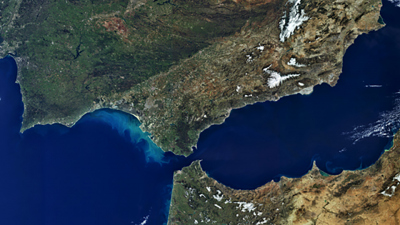- Home
- Discover
- Archive News
- News 2022
- Megafloods
New study on megafloods in the Mediterranean Sea
The Mediterranean Sea almost completely dried out during the so-called Messinian salinity crisis between 6 and 5.3 million years ago. Tectonic plate movements closured the connection to the North Atlantic leading to isolation of the Mediterranean Sea. Along with the drying marine life went extinct in that area. After 630.000 years this crisis was ended by a catastrophic megaflood about 5.3 million years ago by a collapse of the blocked passage at the level of today's Gibraltar. The enormous reflooding even lowered global seal level.
Prior to the new study it was suggested that normal marine conditions reestablished right after the megaflood event. The new study lead by Udara Amarathunga, Andrew McC. Hogg und Eelco J. Rohling from the ANU in Canberra reveal a much more complex picture of this dramatic episode in the Mediterranean. Combining numerical modelling and analysis of proxy records helped to resolve long-standing controversies about the end of one of most prominent regional oceanographic perturbations in the geological record. In collaboration with Thomas Westerhold from MARUM an new highly resolved age model for deposits of the eastern Mediterranean Sea was develop that was basis to test the modeling study.
The results show that the Mediterranean basin was flooded within a few years by the salty North Atlantic waters, but it took 26,000 years in the eastern Mediterranean Sea region to establish normal marine conditions. Much longer than previously thought. “It is unlikely to see another transformation of this size anytime soon, making it a unique example of how quickly the Earth system can change its behavior and how long the consequences might affect a region like the eastern Mediterranean Sea,” says Thomas Westerhold.
The study highlights the extraordinary value of scientific ocean drilling and the archived core material that is a major source for primary information needed to test numerical modeling techniques. “To improve our understanding of environment shaping events and climatic response to changes in boundary conditions for life future scientific ocean drilling is an indispensable tool worldwide.”
Udara Amarathunga, Andrew McC. Hogg, Eelco J. Rohling, Andrew P. Roberts, Katharine M. Grant, David Heslop, Pengxiang Hu, Diederik Liebrand, Thomas Westerhold, Xiang Zhao, Stewart Gilmore: Sill-controlled salinity contrasts followed post-Messinian flooding of the Mediterranean. Nature Geoscience (2022) DOI: 10.1038/s41561-022-00998-z
Contact:
Dr. Thomas Westerhold
MARUM – Center for Marine Environmental Sciences
University of Bremen
Email: [Bitte aktivieren Sie Javascript]



